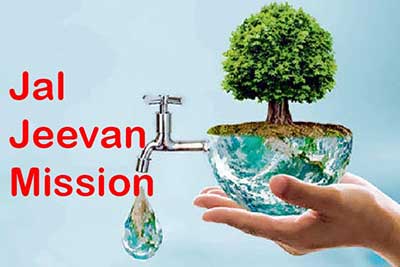Relevance: GS-2: Government policies and interventions for development in various sectors and issues arising out of their design and implementation.
Key phrases: Jal Jeevan Mission, Functional Household Tap Connection, Grey water management, Water conservation, Rain water harvesting, Inflation in commodity prices, Groundwater contaminants, public agitations, Smart water supply systems.
Context:
- The commodity supercycle has impacted the roll-out of the government’s flagship scheme to connect every household with tap water, the Jal Jeevan Mission.
- Government has witnessed improvements with the Jal Jeevan Mission. The coverage of drinking water at the household level has improved from 16% to 49%. Also, 33% of new households have started receiving water, which has helped relieve some pressure.
- The tap connections under this mission are called Functional Household Tap Connection (FHTC). The functionality means quality water, and quantity means at least 55 litres of water per day per person along with regularity.
- Through this scheme government is close to reaching 100% water connections in areas such as Bundelkhand, whose 11 districts used to remain extremely water scarce. Similarly in drought prone areas of Telangana, the challenges have been met. States such as Bihar today have more than 95% of households with running tap water.
Jal Jeevan Mission (JJM)
- Jal Jeevan Mission, is envisioned to provide safe and adequate drinking water through individual household tap connections by 2024 to all households in rural India.
- Government of India launched Jal Jeevan Mission (JJM) in August 2019.
- The programme also implements source sustainability measures as mandatory elements, such as recharge and reuse through greywater management, water conservation, and rainwater harvesting.
- The Jal Jeevan Mission is based on a community approach to water and includes extensive Information, Education and communication as a key components of the mission.
- The Jal Jeevan Mission converges with other Central and State Government Schemes to achieve its objectives of sustainable water supply management across the country.
- The fund sharing pattern between the Centre and states is 90:10 for Himalayan and North-Eastern States, 50:50 for other states, and 100% for Union Territories.
What are the challenges to achieve the objectives of JJM?
- The inflation in commodity prices is a huge impediment because it has affected the tenders and ultimately the work. The rise in prices of steel and plastic has affected the costs of pipes, which were previously available at 50% of the current costs. Because of the price rise, the contracts awarded earlier have become unviable for the concessioners.
- The presence of groundwater contaminants such as fluoride, arsenic, and other heavy metals in around 56,788 households across 18 states is a major challenge for the JJM to provide adequate water quality
- India has diverse climatic conditions and water demand varies accordingly. To provide round the year water supply, JJM needs additional infrastructure developments.
- Habitation settlement pattern varies from village to village, while some places have dense settlements others are diverse. The per capita capital cost varies accordingly and JJM needs to address these patterns to provide FHTC to all households.
- Many states in India face Natural Calamities / Seasonal Hazards such as Kerala and north-eastern states which face floods while western places such as Gujarat and Rajasthan face droughts. To supply water regularly during these conditions, sufficient regional-level infrastructure projects are required to support JJM.
- Cultural Practices in different parts of the country vary in the demand for water from village to village. Methodology to incorporate such regional requirements needs to be addressed in JJM.
- Water being a State subject, the institutions need a better corporation with national and state-institutions for effective implementation and monitoring of the infrastructure.
- Project implementation faces several difficulties such as public agitations due to lack of awareness. Forest and tribal areas need awareness activities to welcome the water supply infrastructure.
- State Government Management needs skilled expertise in the field of new water management concepts for incorporating efficient systems.
Which are the better performing states?
- The first state to reach 100% status is Goa, followed by Telangana, and Haryana. Madhya Pradesh, Gujarat, Punjab, are doing exceptionally well. There are 12 states that are moving towards the 100% status.
- Three states and three Union Territories have achieved 100% status. Himachal Pradesh, Bihar, Sikkim are above the 90% mark. Maharashtra, Manipur, Arunachal Pradesh, Uttarakhand, Mizoram, Jammu and Kashmir, are between the 60-70% mark.
Which states are lagging behind?
- The work in Uttar Pradesh was delayed as we were stuck in areas like Bundelkhand. The work for the project started in around 2021with aim to have 80 lakh tap water connection in UP by the end of 2022. But, the most unfortunate state is Rajasthan. We started with 12% water connections but have only managed to reach 23-24%. Progress in the state has been slower compared to the other states.
- West Bengal, Rajasthan, Jharkhand and Chhattisgarh are really critical states which we are worried about.
Way Forward:
- JJM which aims to provide infrastructure for water supply is a very fundamental requirement for every household. Such missions are to be welcomed and appreciated for addressing such necessities of human life.
- But the success of JJM is dependent on its ability to address regional level issues along with sustainable management of water sources. More diverse and decentralized planning along with local innovations in implementation can support effective and smart water supply systems.
- As a way forward JJM can also address infrastructure for increased water demand based on population, agricultural and other water requirements in a more water sensitive planning approach for the overall economic growth of the country.
Source: Live-Mint
Mains Question:
Q. Discuss the role of Jal Jeevan Mission to ensure water sustainability in India. What are the challenges to achieve the objectives of JJM?? Critically Examine.








